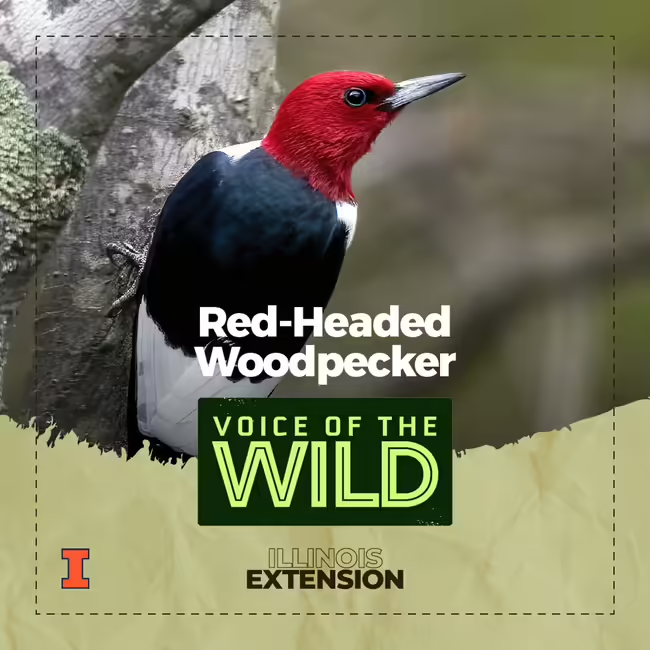
Episode Number
34
Episode Show Notes / Description
Red-headed woodpecker (Melanerpes erythrocephalus).
The only midwestern woodpecker with a head that’s red from nape to throat.
Do you want to learn more bird songs, frog calls, and insect noises? Join Voice of the Wild every Friday to explore a new wild voice. We’re available on most podcast platforms, including Apple Podcasts, Spotify, and YouTube.
Subscription links Here
Subscribe to the Newsletter
Listen online on our Homepage
The following Cornell Lab | Macaulay Library recordings were used in this episode:
- Red-headed woodpecker "WEIRD!" call by Geoffrey A. Keller ( ML507275)
- Red-headed woodpecker staccato call by Benjamin Clock (ML507273)
- Red-headed woodpecker "hoarse laugh" with hammering by Robert C. Stein and William W. H. Gunn (ML507276)
- Red-headed woodpecker hammer by Geoffrey A. Keller (ML507277)
Sources and more:
- https://www.fs.usda.gov/database/feis/animals/bird/meer/all.html#57
- https://www.allaboutbirds.org/guide/Red-headed_Woodpecker
- https://www.audubon.org/field-guide/bird/red-headed-woodpecker
- Dobson, Colin et al. Field Guide to Hotspots and Birds in Illinois. Champaign-Urbana: Scissortail LLC, 2023. Print.
- Godfrey, Michael A, John Farrand, and Roger Tory Peterson. Videoguide to the Birds of North America. New York, N.Y: MasterVision, 1985. Film.
- Peterson, Roger Tory, and Virginia Marie Peterson. A Field Guide to the Birds: A Completely New Guide to All the Birds of Eastern and Central North America. Fourth edition, completely revised and enlarged. Boston: Houghton Mifflin Company, 1980. Print.
- Sibley, David. Sibley Birds East: Field Guide to Birds of Eastern North America. Second edition. New York: Alfred A. Knopf, 2016. Print.
Transcript
This is Illinois Extension’s Voice of the Wild. A new wild voice in just a moment, so find someplace quiet, take a deep breath, and enjoy.
In the kind of open woodland this sensational woodpecker prefers, a few sturdy wingbeats is all it takes to send it from oak to oak and snag to snag. It inquisitively searches these big trees for grubs, beetles, and nooks to hide a stash of acorns. In the spring and summer they form rambunctious social groups that nest together in these woods. If the crop of acorns and other tree mast is good enough, they’ll even stay for winter. Their high-contrast plumage is a welcome sight at any time of the year, but on a gloomy winter day its red head, big white wingpatches, and white rear, seem an especially extravagant treat. And While all the woodpeckers of the midwest have at least a little red on their head, only this one has red from nape to throat.
This is the red-headed woodpecker (Melanerpes erythrocephalus) from the woodpeckcer family, Picidae.
Being a woodpecker, this bird makes sounds both nonvocal and vocal…I’ll point out three vocaliztions here; the harsh and untrilled call which sounds like “cheer” or an accusatory “weird," a staccato call that’s given in a similar voice, and last, they have a kind of hoarse laugh-like sound they give when they’re being social…and Alltogether, here’s the redheaded woodpecker again.
Thank you to the Macaulay library at the Cornell lab for our bird sounds. And thank you for tuning in to learn a new wild voice with Illinois Extension.
In the kind of open woodland this sensational woodpecker prefers, a few sturdy wingbeats is all it takes to send it from oak to oak and snag to snag. It inquisitively searches these big trees for grubs, beetles, and nooks to hide a stash of acorns. In the spring and summer they form rambunctious social groups that nest together in these woods. If the crop of acorns and other tree mast is good enough, they’ll even stay for winter. Their high-contrast plumage is a welcome sight at any time of the year, but on a gloomy winter day its red head, big white wingpatches, and white rear, seem an especially extravagant treat. And While all the woodpeckers of the midwest have at least a little red on their head, only this one has red from nape to throat.
This is the red-headed woodpecker (Melanerpes erythrocephalus) from the woodpeckcer family, Picidae.
Being a woodpecker, this bird makes sounds both nonvocal and vocal…I’ll point out three vocaliztions here; the harsh and untrilled call which sounds like “cheer” or an accusatory “weird," a staccato call that’s given in a similar voice, and last, they have a kind of hoarse laugh-like sound they give when they’re being social…and Alltogether, here’s the redheaded woodpecker again.
Thank you to the Macaulay library at the Cornell lab for our bird sounds. And thank you for tuning in to learn a new wild voice with Illinois Extension.